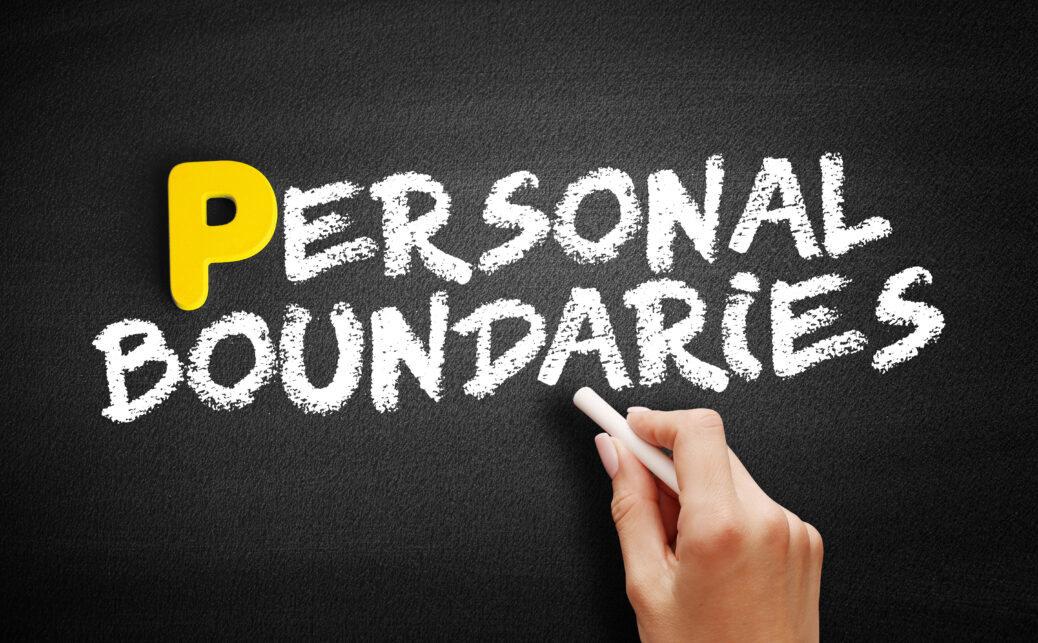Drawing the Line: The Importance of Setting Boundaries
Introduction
You’re the one everyone turns to. The go-to problem solver. With everything you manage to juggle, people often say you must have a superpower. They marvel at your ability to do it all, commenting on your endless reserves of energy and dedication.
But pause for a moment and ask yourself: Is this genuinely my superpower, or is it time to start setting boundaries?
In our journey through life, we encounter various people and situations that challenge our sense of self and our well-being. One of the keys to navigating these encounters successfully is setting and respecting boundaries. This might sound simple on the surface, but the actual act of setting, communicating, and maintaining boundaries is often anything but.
What is a Boundary?

Think of a boundary like a fence for your own emotional, mental, and physical well-being. We often associate fences with physical territories – they determine where one’s property begins and ends, which offers security and clarity. Now, imagine this concept, but instead of land or property, think of yourself and your needs. Just as a fence keeps out unwanted intruders, your personal boundaries help you safeguard your emotional and mental space from unwanted influences, pressures, and demands. They are the unspoken rules that dictate what behaviors you will accept from others, and which ones you won’t.
Setting boundaries is important for maintaining our own well-being and promoting healthy relationships with others:
- They guide others on how they wish to be treated
- They protect you from feeling overwhelmed or exploited.
- They help establish mutual respect in relationships.
- They help protect your identity and mental health, giving you room to breathe and grow.
Conversely, not setting boundaries can lead to various negative consequences, including feeling taken advantage of, having difficulty in making decisions, and difficulty in maintaining healthy relationships. It can also lead to feeling resentful, disempowered, unheard, and guilty.
Why Is It Hard to Set Boundaries?

Setting boundaries is a form of self-care. Yet, many people struggle with setting boundaries. This can be from cultural, societal, or familial expectations, where one might be conditioned to put the needs of others before their own. Oftentimes assertiveness might be misconstrued as rudeness. For others, past experiences or traumas might make the very act of setting boundaries feel like stepping on treacherous ground, evoking fears of backlash, rejection, or conflict.
Let’s address some of the reasons why setting boundaries can be difficult:
- Fear of Conflict or Rejection: “What if they don’t like my boundaries?”
Setting boundaries can feel daunting because we can’t predict how others will react. However, setting boundaries is about protecting your well-being, not necessarily pleasing others. Even if someone doesn’t like it, remember that your needs and feelings are valid. Relationships built on mutual respect will honor those boundaries.

- Self-Esteem: “Do I even deserve to set this boundary?”
Every individual has the right to their feelings, needs, and boundaries. Your worth isn’t determined by what you allow or disallow from others. By setting boundaries, you’re practicing self-respect and self-care, and you deserve that.
- Emotional Turmoil: “I don’t want to hurt anyone.”
Your intention in setting boundaries isn’t to hurt others but to protect your own well-being. It’s possible to set boundaries with kindness and clarity. If someone is hurt by a boundary you set, it may be a reflection of their expectations rather than any harm you’ve caused. You’re allowed to prioritize your well-being.
- People Pleasing: “Maybe it’s okay just this once?”
It’s natural to want to make others happy, but repeatedly compromising your boundaries can lead to feelings of resentment or burnout. It’s okay to stand firm. Remember, consistently upholding your boundaries helps others understand and respect them.
- Lack of Knowledge: “How do I even start?”
Many people were never taught how to set boundaries or foster healthy relationships, which can make it difficult to know where to start. Starting can feel overwhelming, but you’ve already taken a big step by recognizing the need for boundaries. Remember, setting boundaries is a journey, and every step you take is progress.
Common Signs You Need to Set Boundaries

If you’re reading this, there’s a chance you might need some firmer boundaries in your life. Maybe you’re feeling a bit tired or overwhelmed, or maybe you’ve noticed that some relationships in your life are more difficult than others.
If you’re still unsure whether you need to set boundaries, here are some tell-tale signs that it might be time to learn how to establish stronger ones in your life:
- You constantly feel taken advantage of in certain situations, such as emotionally, financially, or otherwise.
- You don’t feel like you have a work/life balance.
- You take care of others without thinking of your own needs.
- You feel like you’re constantly giving without receiving much in return.
- You always feel like you have too much on your plate.
- Your relationships are difficult to maintain and tend to be dramatic.
- You find yourself doing things you don’t want to do or find upsetting and harmful.
- You feel guilty saying “no”.
- You find yourself constantly venting or acting passive-aggressively.
Setting Healthy, Effective Boundaries

When it comes to setting healthy and effective boundaries, the way you communicate can make all the difference. It’s important to make sure to find the right words to make sure your message is received in the spirit you intended. And to set up your intended audience for success in respecting your boundaries. Here are some strategies to consider:
Define your limits:
Before you can communicate your boundaries, you need to know what they are. Reflect on what makes you comfortable and what doesn’t. If you ever start to feel guilty, remind yourself of the reasons why you set the boundary in the first place and the benefits it provides.
- Example: After attending several late-night parties with her friends, Maria realized she was consistently feeling drained and unrested the next day. After reflecting, she identified that her limit was staying out past 11 p.m. She felt much more comfortable leaving events by that time to ensure she got a good night’s sleep.
Use “I” Statements:
When communicating your boundaries, use “I” statements to create a collaborative conversation and prevent sounding critical.
- Example: In a conversation with her roommate about cleanliness, instead of saying, “You always leave your dishes in the sink,” Lena says, “I feel stressed when the kitchen is cluttered. Could we discuss a cleaning schedule?”
Be Clear and Direct
The more precise and direct you can communicate your boundaries, the easier it will be to uphold them. Boundaries are like the “rules” of a relationship. When they’re displayed for all to see, it’s easier for everyone to follow them.
- Example: When starting a new project with his team, Tom says, “For this project, I’d prefer to receive all communication through our project management tool, rather than through texts or separate emails. This way, I can keep everything organized.”
Repeat Yourself If Necessary
It may take some time for others to adjust to your boundaries, so don’t be afraid to repeat yourself if necessary. Be patient and consistent in your communication.
- Example: After her friend forgets for the third time, Carla gently reminds her, “Remember, I mentioned I can’t take phone calls after 9 p.m. because it’s my wind-down time. Please let’s try to talk earlier, or we can always chat the next day.”
Be Assertive
When communicating your boundaries, be assertive and confident. Remember that you have the right to set boundaries and take care of yourself. Remember that setting boundaries is not selfish, but rather a form of self-care.
- Example: When James’s colleague consistently interrupts him during meetings, he confidently states, “I need to finish my point before you jump in. Can you please wait until I’m done speaking?”
Practice Self Compassion
It’s important to set realistic expectations for yourself and understand that it’s okay to prioritize your well-being. Don’t beat yourself up if you mess up or start to feel guilty. Be kind to yourself and recognize that setting boundaries is a skill that takes practice and remind yourself that you’re doing what’s best for you.
- Example: When Lucas noticed his coworker taking his stapler again, overstepping a personal boundary they had discussed, he hesitated to reassert himself. Instead of scolding himself for not being firmer, he took a moment to acknowledge his feelings and remind himself that assertiveness is a skill that needs practice. Recognizing his own growth, he felt more confident to discuss his boundary again with his coworker.
Maintaining & Enforcing Your Boundaries

After establishing a boundary, you might believe the hardest part is over. However, setting the boundary is just the beginning. The real challenges surface when your boundaries are resisted or overlooked. People who are not used to the new limits you’ve set might challenge or inadvertently breach these boundaries either out of curiosity, resistance, or habit.
Sometimes, the pushback can be subtle, like a small nudging at the edges, while at other times, it can be blatant, feeling more like a bulldozer trying to tear down a wall you’ve erected. Both instances require your attention. You’ll need a strategy in place to reinforce the boundaries you’ve set and ensure they’re respected. Here are some steps to ensure they remain intact and are respected by people around you:
Stay calm:
It’s important to stay calm and not get defensive when someone pushes back on your boundary. Take a moment, breathe, and approach the situation with clarity.
Reiterate your boundary:
Restate your boundary in a clear and direct manner. If they violated your boundary, let the person know that what they did wasn’t okay. Keep it simple and avoid over-explaining
Listen to the other person:
Listen to the other person’s perspective and try to understand where they’re coming from. However, don’t compromise your boundaries if it’s important to you. If the other person’s needs conflict with your boundary, try to find a compromise that works for both of you and doesn’t negatively impact your own well-being and values.
Enforce consequences:
If the other person continues to push back on your boundary, you may need to enforce consequences. Be clear about the consequences and follow through with them if necessary. This can be limiting communication or time spent with this person, or even cutting them off completely.
Examples of Healthy Boundaries
There have been lots of conversations about boundaries recently in the media, particularly about defining healthy vs. unhealthy boundaries. Boundaries can be healthy or unhealthy, depending on whether they respect yourself and others.
Healthy boundaries involve respecting your own and others’ values, wants, needs, and limits. Unhealthy boundaries involve a disregard for those things. Unhealthy boundaries can also lead to potentially abusive situations and toxic relationships.
Healthy and unhealthy boundaries can look different for each person and relationship. Here are some examples of healthy and unhealthy boundaries.
Healthy boundaries:

- Are not compromised for someone else. Nor do they compromise or violate other people’s.
- Example: Lucy had always valued her Friday evening yoga sessions. When her partner asked her to skip it for a last-minute event, she explained its importance and suggested they find another time to attend an event together.
- Saying “no” and accepting when others say “no”
- Example: Mark asked Jenna if she’d like to watch a scary movie with him. Jenna reminded him, “No thank you, remember I can’t watch scary movies because I won’t sleep well.” Mark responded, “No worries, let’s watch something else!”
- Encourage ownership and agency over yourself and your assets (e.g., your time, your space, your things, etc.)
- Example: Aisha told her roommate, “I’m okay with you borrowing my clothes occasionally, but please ask before taking them. I like to know where my things are.”
- Communicate your wants and needs in a relationship, while also respecting the wants and needs of the other person in the relationship
- Example: Ryan expressed to his partner, “I know you asked to see each other more frequently during the week and I really value our time together, but I also need a night or two a week for my own activities. How can we balance this so we both feel fulfilled?”
Unhealthy boundaries:

- Disregard the values, wants, needs, and limits of yourself or others. Involve accepting abuse and disrespect, fearing rejection if you do not please the other person.
- Example: Mia’s partner set a boundary about her embarrassing him in public. Afraid of her partner’s reaction, Mia tolerated his offensive remarks about her family when he was joking with his friends, thinking it was the only way to keep him happy and in her life.
- Violate people’s autonomy and consent. Involve not saying “no” or not accepting when others say “no”.
- Example: Even though she had asked him not to, Alex felt that because he and Clara were close friends, he could take her things without asking or use her accounts without her consent.
- Cause one person to feel they are solely responsible for another person’s feelings and happiness or responsible for “fixing” or “saving” another person.
- Example: Kara explained to Adam that after her previous relationship, it was important for her partner to not add any more stress to her day. Adam constantly felt the pressure to ignore his own needs and concerns while cheering up Kara every time she was sad. He believed that if she wasn’t happy, it was his failure.
- Involve little care or concern about your health/safety.
- Example: Jane set a boundary with her roommate after her cats scratched her door asking her roommate to allow her cats to roam free throughout the house. Jane dismissed her roommate when she reminded Jane about her allergy to cats.
Conclusion
Establishing and maintaining boundaries is an ongoing journey of self-awareness, communication, and respect. By recognizing our limits and communicating them effectively, we pave the way for healthier, more fulfilling relationships. It’s not just about saying “no” or keeping others at arm’s length, but about understanding and honoring our value and the value of those around us. As we navigate the complex web of relationships in our lives, our boundaries serve as guiding lights, illuminating a path of mutual respect, understanding, and growth.
Stay informed and receive resources and site updates by subscribing to our Newsletter!
Resources
- Boundaries: What are they and how to create them | Wellness Center | University of Illinois Chicago. (n.d.). https://wellnesscenter.uic.edu/news-stories/boundaries-what-are-they-and-how-to-create-them/
- Casabianca, S. S. (2022, October 28). 7 signs Someone doesn’t respect your boundaries and what to do. Psych Central. https://psychcentral.com/relationships/signs-boundary-violations
- Lcsw, S. M. (2016, July 11). How to Deal with People Who Repeatedly Violate Your Boundaries. Psych Central. https://psychcentral.com/blog/imperfect/2016/07/how-to-deal-with-people-who-repeatedly-violate-your-boundaries
- Lpc, T. H. M. N. C. (2018, August 29). Toxic Behaviors: 12 Examples of Unhealthy Boundaries. Psych Central. https://psychcentral.com/blog/caregivers/2018/08/toxic-behaviors-12-examples-of-unhealthy-boundaries#1
- Moore, M. (2022b, September 8). The importance of personal boundaries. Psych Central. https://psychcentral.com/relationships/the-importance-of-personal-boundaries
- Lee, K. (2018, September 11). Why Is It So Hard to Set Boundaries? Psychology Today. https://www.psychologytoday.com/us/blog/rethink-your-way-the-good-life/201809/why-is-it-so-hard-set-boundaries
- Durvasula, R. (2022). 9 Signs of Poor Boundaries (And What to Do Instead). MedCircle. https://medcircle.com/articles/signs-of-poor-boundaries/
- Smith, M., MA. (2023). Setting healthy boundaries in relationships. HelpGuide.org. https://www.helpguide.org/articles/relationships-communication/setting-healthy-boundaries-in-relationships.htm



